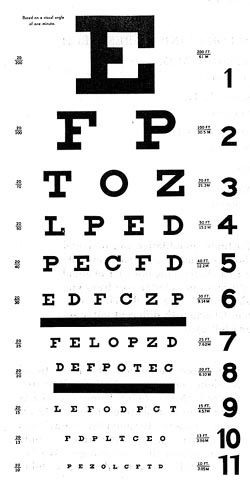There are many different vision problems that people may have, and many tests for these. An optometrist is usually consulted for testing, while an ophthalmologist may also do eye tests. There is also information about vision testing for athletes.
 equipment required: eye chart (e.g. Snellen chart), computer software and other specialist optometry equipment.
equipment required: eye chart (e.g. Snellen chart), computer software and other specialist optometry equipment.
procedure: Here is a list of some of the areas that can be tested.
- Visual Acuity — Vision is often tested using a Snellen chart or similar, the traditional eye examination. Being able to read the line designated 20/20 (usually the 8th row), is the smallest line that a person with normal acuity can read at a distance of twenty feet. Outside the US, six meters is used and normal vision is designated 6/6. Good visual acuity means the athlete is able to sharply focus on the ball and opposition players. Vision can be corrected with spectacles or contact lenses.
- Depth Perception — ability to locate items in space. Good binocular vision, when both eyes are working equally well, is linked to better depth perception.
- Contrast Perception — testing the ability to separate objects from their background.
- Color Blindness — testing the ability to distinguish colors.
Treatment: There is a range of possible treatments depending on the problem, including corrective lenses (spectacles or contact lenses) and sports vision training. Surgery is also an option for some eye defects.
Related Pages
- Vision testing for athletes
- Testing for color blindness
- Testing for Eye Dominance in sports
- About Sports Sunglasses — it's more than just style
- Full list of health tests
- Health Tests for Athletes


 Current Events
Current Events